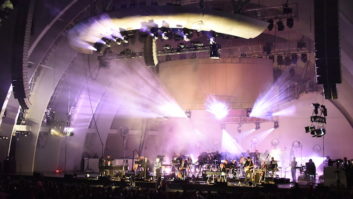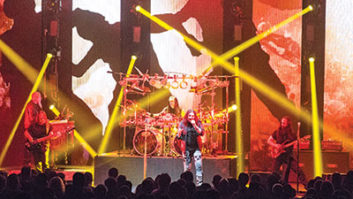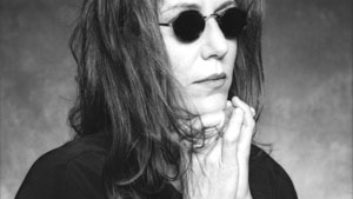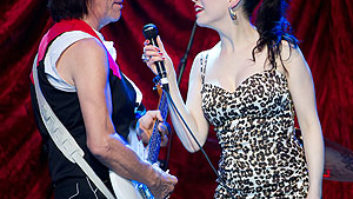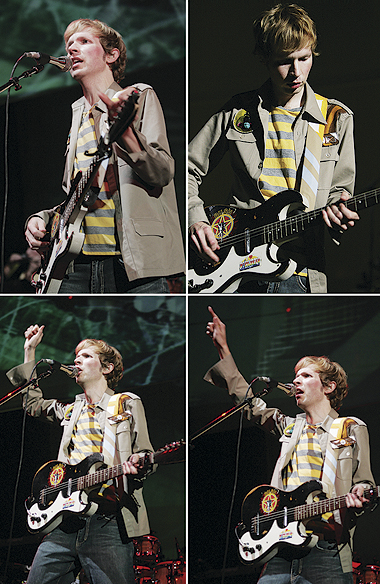
“There will be dining room tables onstage,” Beck recently said in Rolling Stone, “and meals will be had.” Hinting at culinary surprises, the reigning champ of rock ‘n’ roll irony announced his upcoming U.S. tour, which follows his latest release, Guero, the wildly successful result of his latest collaboration with the Dust Brothers. Beck played a string of early West Coast dates in July to warm up for the “official” fall tour; Mix caught stops at the San Jose Civic Center and the Bill Graham Civic Auditorium in San Francisco.
Sound for the tour is provided by Clair Bros.; front of house is being mixed by Sean “Sully” Sullivan, a touring veteran who recently wrapped up arena gigs with Mary J. Blige, Justin Timberlake and, most recently, Ashlee Simpson, joining the Beck crew for five-and-a-half weeks in Europe before the U.S. schedule.
The pre-tour shows hit mid-sized venues, ranging from 2,000 to 8,000 seaters. Used to working in arenas and at open-air festivals, Sullivan faced P.A. limitations in the smaller halls. “The weight restrictions are way lower than what you really need; I have to spec a lot of front-fills for that reason, but I’d much rather be able to put the P.A. up,” he says. His rig is a Clair Bros. i4 curved linear array with T-2 double-18 subs. The band is relying on wedge monitors (Clair 12am and double 12am; sidefills are a Clair R-4 over a Showco Prism II sub per side), so the sound team recently began experimenting with Clair’s version of cardioid sub stacks to help keep the “wall of sound” under control. “The monitor engineer [Maurizio Gennari] and I both have a lot of firepower. We don’t necessarily fight each other, but we’re not necessarily helping each other,” Sullivan continues. “This show has a tremendous amount of bottom end, and Beck’s not always a really loud singer, so it kind of makes it hard for him to hear himself onstage at times. The drummer is the only one on in-ears, so the amount of low end that I’m mixing is killing the stage. What I’m trying to do is not necessarily a cardioid sub pattern, but there’s a lot of cancellation behind the stack by the way we’re doing it.” Although the thick Dust Brothers — influenced tracks lean toward heavy bass energy, the arrangements add definition to the stage mix. “His music has a lot of space: When he’s wailing on guitar, he’s not trying to sing. He helps me on that point.”
THE INCREDIBLE SHRINKING FOH
Sullivan spec’d a highly compact FOH rig based around a Yamaha PM5D board and a pared-down rack of outboard essentials: a TC Electronic 2290 delay, two Eventide Eclipse multi-effects units, a Big Muff stomp box for distortion on vocals and a Focusrite ISA430 Producer Pack mic pre/compressor/EQ. A minimalist, Sullivan shies away from schlepping overblown gear rigs and large-format boards around the world. “I don’t have an ego problem. I just bring what I need,” he jokingly says.

Front-of-house engineer Sean “Sully” Sullivan
Keeping Beck’s restrained vocal clearly defined in the mix is paramount. “I’m definitely compressing and EQ’ing it to get it in front of everything else out here,” Sullivan says. “The mic goes straight into the Focusrite and into a line input.” All EQ and compression on Beck’s vocal is through the Focusrite 430. “I don’t have to worry about scenes, and the vocals will sound consistent from song to song,” he explains. “There are 75 to 80 songs rehearsed and I have a scene for almost every one of them.” Mixing Beck can be an exercise in spontaneity; the 90-minute set list changes every night, based on “whatever he feels like putting together,” Sullivan says. “We’ll soundcheck 12 songs and won’t do any of them that night. But we always have similar starts and endings.”
All other dynamic processing is done inside the console. Sullivan also taps into Yamaha’s channel strip plug-in package and runs Studio Manager on his laptop. Sullivan says he’s “pretty happy with the PM5D. It’s limited on channels — 56 mics in and eight lines in at a time — and I’m using every single one of them. I’m even ‘Y-ing’ a lot of microphones onstage. But since we are carrying our consoles with backline, we didn’t want a massive set of board groups and I prefer a programmable console.” He archives the shows with MOTU’s Digital Performer, running on a G4 Powerbook rig with a Metric Halo 2882+DSP Firewire interface. The monitor setup largely mirrors FOH, including another PM5D, and a TC Electronic 2290 delay and 1128 EQs for all mixes except the drummer, who mixes his in-ears with a Yamaha 01V.
MULTITASKING MUSiCIANS, MULTITASKING MICS
Instruments clutter the stage — “We always say it looks like Guitar Center threw up onstage,” Sullivan says — and backline includes two guitars, bass, synth bass, keyboards and drums; all bandmembers double on percussion at their stations. Congas, bongos and even a cocktail kit are shared by Beck, the keyboard player, the second guitar player and an interpretive dancer. In addition, the drummer plays loops and triggers from an Akai MPC, and the keyboard player runs loops, effects and samples in Reason and Ableton Live. “It’s really just for the exotic stuff — sounds that were not made with traditional instruments, which he has a lot of,” Sullivan says. “It’s controlled chaos.”

Monitor engineer Maurizio Gennari
The mic list is routine, with a few exceptions. Beck sings into an Audix OM6, while the rest of the band use Shure Beta 58s; guitars are all Shure KSM32s. The drum kit is mostly Shure, with a VP88 on overheads, “which isn’t really that standard, but for me it is. The VP88 is a mid-side [M-S] configuration. I use the PM5D’s internal M-S decoder to vary the width from near-mono to beyond stereo. Placement is behind the drummer, kind of above his head for more of a kit sound,” Sullivan explains. “I’m not really a fan of close-miking overheads, so that’s more like a drum ambient kit mic.” Snares are 57s, kick is a Beta 52 and toms are Audio-Technica Artist Elite AE3000s. As for the hi-hat, “It is not really just a hi-hat mic; there’s a bunch of percussion stuff he has over there, so one KSM32 is used as an area mic for all of it.”
ABOUT THAT MEAL
About halfway through the show, the dining room scene Beck alluded to finally materializes onstage, when the band gathers around a dinner table to share a meal while Beck works through a solo guitar set featuring medleys of acoustic ballads and, occasionally, somewhat bastardized versions of pop hits. (Nelly’s “Hot in Herre” and Prince’s “Purple Rain” were covered at the San Jose show.) Little by little, the bandmembers quietly begin swirling their water glasses, tapping their plates and bowls and thumping on the table, eventually building to a crescendo for the percussive grooves of “Clap Hands.”
Miking the frenzied table action was a double challenge: Because the tabletop was projected onto a large overhead screen, mic visibility had to be kept to a minimum. Sullivan also needed to minimize mic inputs going into the PM5D. Shure SM91 boundary mics were a random experiment that ended up working perfectly. “I had never miked a table; what do you put on it?” Sullivan questions. “Beck happened to have a 91 in his trunk. We tried it in rehearsal, and it worked really well.”
Two contact pickups mounted on the wine glasses’ stems are routed through a Smokey mini amplifier that “looks like a cigarette pack with a cigarette in it,” Sullivan describes. “We point that at the 91s. We really don’t have inputs; that’s why we’re doing it like that. It’s quiet [onstage then] — if there was anything else going on, we wouldn’t be able to do it.” There are no effects on the feeds from the tabletop. “I tried putting a little ambience on it, but you know most of these buildings have that built-in,” he says.

Glasses are tuned so that the keyboardist can play them during a song. The crew researched using pre-tuned glasses, but “we found that they were a couple hundred bucks a piece,” Sullivan remembers. “We use Crate and Barrel [glasses]; you take five of them out of the box, they all look the same, three sound like garbage, one will sound good and one will sound great. None of us ever knew [what it would sound like] until we miked a table and listened to it.” He adds that the bass tech is doubling as a glass tech.
This month, Beck returns for his full-fledged U.S. tour, including select dates opening for the Rolling Stones. Hopefully, that fine stemware will hold up.
Sarah Jones is Mix’s features editor.
